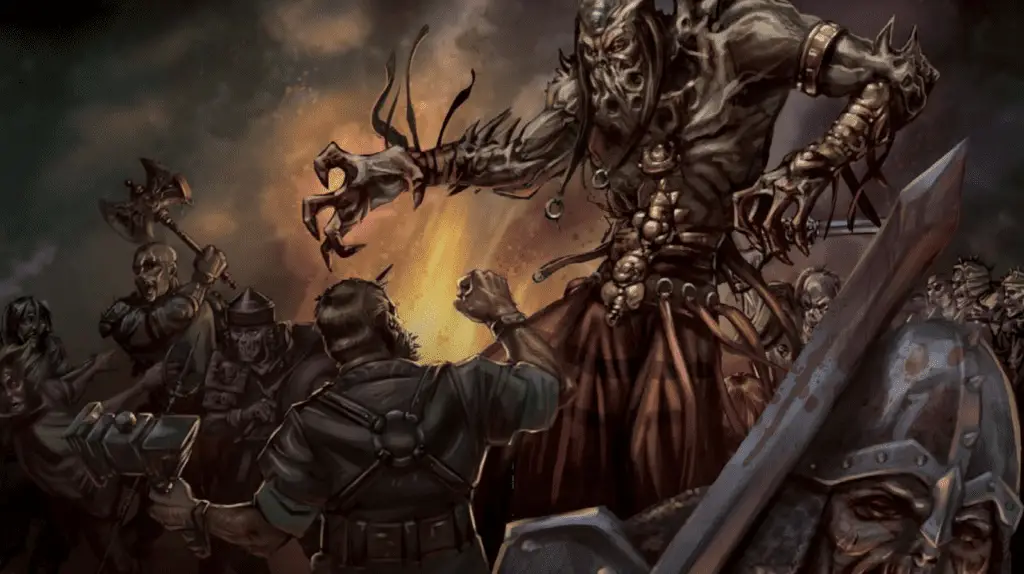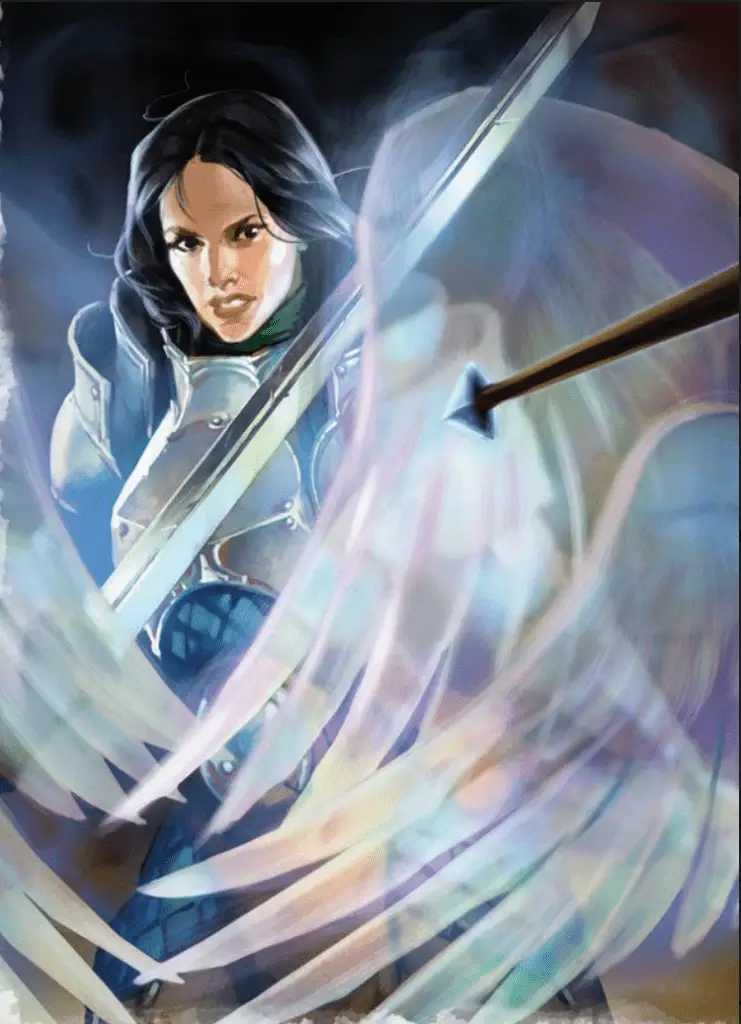The Dragon Age series is one that I hold near and dear to my heart, as I’m sure many other fantasy-loving nerds do. Few other sagas can match it in sweeping scale, character drama, political intrigue, or fantastical worldbuilding. With all of its clout and dedicated fanbase, it would make for a perfect TV show, film, or even better: tabletop RPG. Written by Chris Pramas and first published by Green Ronin Publishing in 2010 (its most recent major update was in 2015 following the release of Dragon Age: Inquisition), Dragon Age aims to bring the lush world and dark fantasy threads of Thedas to tabletop gaming. Hoo boy, does it succeed. Let’s dive in, shall we?
Presentation + Introduction

Right off the bat, the Core Rulebook is detailed, easy to read, long, simple to absorb, beautiful (it earned that Gold ENnie Award for Best Internal Art in 2016), and long. Did I mention long? The most recent edition of the Core Rulebook is looong. We’re talking 440 pages. Each page is absolutely packed with in-depth information about every tiny aspect of the game. While this may seem daunting to those wishing to play this game, never fear. There is a free quickstart guide available on Green Ronin’s website perfect for picking up the rules and playing in a timely manner without needing to sift through pages and pages of character creation and abilities. Creating a character and starting a game is actually much simpler than it first appears. Unlike many other RPGs, there aren’t swaths of races, classes, and subclasses to carve through before you find your perfect fit. Thanks to the lore ported straight from the games, Dragon Age only has four races and three classes available to play from level 1 (human, elf, dwarf and Qunari; warrior, rogue and mage, respectively). Subclasses, here named “specializations,” become available at level 6.
The only part of character creation that gets a bit winded is the background system. Carried over and expanded from the beloved background feature in Origins, players have thirty options to choose from to describe their character’s background, which will most likely heavily influence how that character interacts with the world and vice versa. A character’s background will also determine certain ability focuses they receive, languages they speak, and even which classes are available to them. The backgrounds are, unsurprisingly, rich and variant, with tons of room for backstory details. While initially intimidating, it’s probably my favorite aspect of character creation due to its significance actually being felt as part of any character build.
One thing about jumping into this game…the rulebook provides extensive, excruciatingly detailed lore about the world of Thedas and its people. I will always recommend playing the games to get a better feel for the world and customs of Thedas, but it is not strictly necessary. I imagine it is mostly hardcore Dragon Age fans who are playing a Dragon Age RPG in the first place, but it’s always good to be aware of the source material!
Mechanics: Simple and Clean
Coming from a background of Dungeons & Dragons 5e, I didn’t know quite what to expect from Dragon Age’s mechanics. I myself am a shameful shameless hoarder of dice, so I was definitely not expecting the only dice used in the game to be a d6. Every ability test in the game requires a roll of 3d6. However, in Dragon Age, there is a unique element added to dice rolls–the Dragon Die. Out of the 3d6, the Dragon Die must be a different color or otherwise differentiated from the other two. This die is responsible for some of the more innovative mechanics unique to this game. For example, if a character succeeds on an ability test, they roll the Dragon Die to determine just how well they did. It can also break ties and, in a special case, determine something called Stunt Points (SP).
Stunts are probably the most creative and innovative part of Dragon Age‘s gameplay. Here’s how it works: if a player rolls two of the same number on an ability test and succeeds, they get to perform a stunt. The number on the Dragon Die determines how many Stunt Points the character can spend doing something cool. My favorite combat stunts include rapid reload and lethal blow. Stunts spice up encounters in a fun and unique way while still keeping the mechanics free-flowing and simple.
The ability focus system seems overwhelmingly large at first, but fortunately players don’t have much to worry about on that front (GMs, godspeed). Players only have to keep track of their ability scores and any ability focuses they pick up from their race, class, and/or background. Character sheets are refreshingly simple and easy to read. As characters level up they will have access to more skills and class specializations, but they are never locked into anything as long as it is within the class distinctions of warrior, rogue, or mage–player options are nearly limitless.
Gameplay: Spells and Specializations

Like most RPGs, Dragon Age isn’t just focused on combat. There are three types of encounter/game environment: combat, exploration, and roleplay. Even in the latter two encounters, stunts are perfectly usable, though they are of course different than the aforementioned combat stunts. Starting at early levels, gameplay and progression are pretty straightforward as the class options aren’t as varied until later levels. When those later levels do come, however, the gameplay gets really interesting. Even better, a character is not limited to just one specialization. A warrior, for example, can choose to take the Templar talent at level 6, progress it to level 10, then choose another specialization such as Reaver. I find it to be a simpler system than, say, multiclassing in D&D. Mages also gain the benefit of being able to use advanced spell stunts separate from regular stunts. It is completely optional for a GM to choose to use these, as it can be argued that it gives mages an unfair advantage over warriors and rogues. However, I would personally say this balances out the mages’ reliance on mana points to cast their spells and would allow these stunts in my game.
Dragon Age really has thought of everything in regards to gameplay; there are systems and tables available for just about any personal goal a character could have. Want to become a Grey Warden? It’s highly encouraged and anyone can be one. Want to join/form an organization for whatever purpose you wish? There’s a guide for that in the rulebook. Your party is part of a massive battle in a world-ending war? There are dedicated encounter templates for huge armies meeting in the field. No stone is left unturned and characters are more than capable of making the expansive world their oyster.
Worldbuilding: A Thedas We Know
Speaking of the world, Dragon Age is helped along by Thedas being incredibly fleshed out in the BioWare titles. The rulebook goes into deep detail about each region, race, faith, society, and the history of Thedas. Even if one has never played the games, they can easily learn about whichever parts of the continent they wish before or during the game. What a world it is–it is not just a layer of flavor over a game system. The culture of Thedas colors every personal interaction, battle, interrogation, even shopping trip the characters make. This is part of why I love the background system so much; it interacts so fluidly and vitally with the worldbuilding carried over from the games.
The game was first published in 2010, before even the release of Dragon Age II in 2011. Thus, a majority of its enemies and conflicts are centered around Blights and the Darkspawn present in the first game. This means that for the most part, there is no direct tie-in with the game materials and the latter two BioWare games. It is mostly up to the GM and players to decide how their game ties into the main story, if at all. Thanks to the detailed history lessons provided by the rulebook, a historical campaign is very much possible, as is a campaign that directly follows Inquisition. Neither the GM nor players will ever be lost for details or have to make up their own, unless of course they prefer to.
One nice touch the game added after the release of Inquisition is the Faces of Thedas sourcebook. This book contains stat blocks and information about several canon characters from the Dragon Age games. It also adds more information on the Dwarven Carta and Antivan Crows, as well as adding new rules for roleplay encounters. Characters can fight alongside or work against beloved characters from the games, making the campaign feel more directly tied to the main installments.
Accessibility: Newbies Greatly Approve
Having been thrown face-first into Pathfinder as my first RPG, I am no stranger to stumbling through a game confused and never quite knowing exactly what I’m doing or how. It’s safe to say Dragon Age would not offer that sort of disorienting experience, even for brand-new players. Its mechanics are simple enough to grasp quickly, players don’t need to keep track of tons of skills, classes are easy to jump right into and play, and the world of the game unfolds around the players, even if they’ve never touched a BioWare game in their life.
Tidbits+Final Verdict

There are a couple aspects of the game I love that didn’t fit in any previous category.
- There are in-depth systems for poisons, grenades, and trap-setting that go beyond what the video games presented. I imagine playing a rogue and utilizing these mechanics would be especially rewarding.
- The art in the core rulebook is gorgeous and there is a ton of it.
- Mounted combat is viable (well, as viable as it can ever be).
Dragon Age is an example of what high fantasy roleplaying games should aspire to. A classic formula combined with beloved worldbuilding, innovative mechanics, and rich encounter potential create a smooth cocktail that tastes of success and, most important of all, fun. Playing a full campaign in this world with this system sounds like a great time and I will most certainly attempt to rope my gaming group into playing at least a short one. I believe all of the aforementioned elements combined with a true dedication to dark fantasy make for a compelling game that can attract any tabletop gamer, regardless of skill level.
You can pick up the Dragon Age RPG at Green Ronin’s shop, as well at Drive Thru RPG. And don’t forget to keep an eye on The Fandomentals for the latest from Green Ronin, Dragon Age, and the world of tabletop.
All Images Courtesy of Bioware and Green Ronin Publishing
Have strong thoughts about this piece you need to share? Or maybe there’s something else on your mind you’re wanting to talk about with fellow Fandomentals? Head on over to our Community server to join in the conversation!

